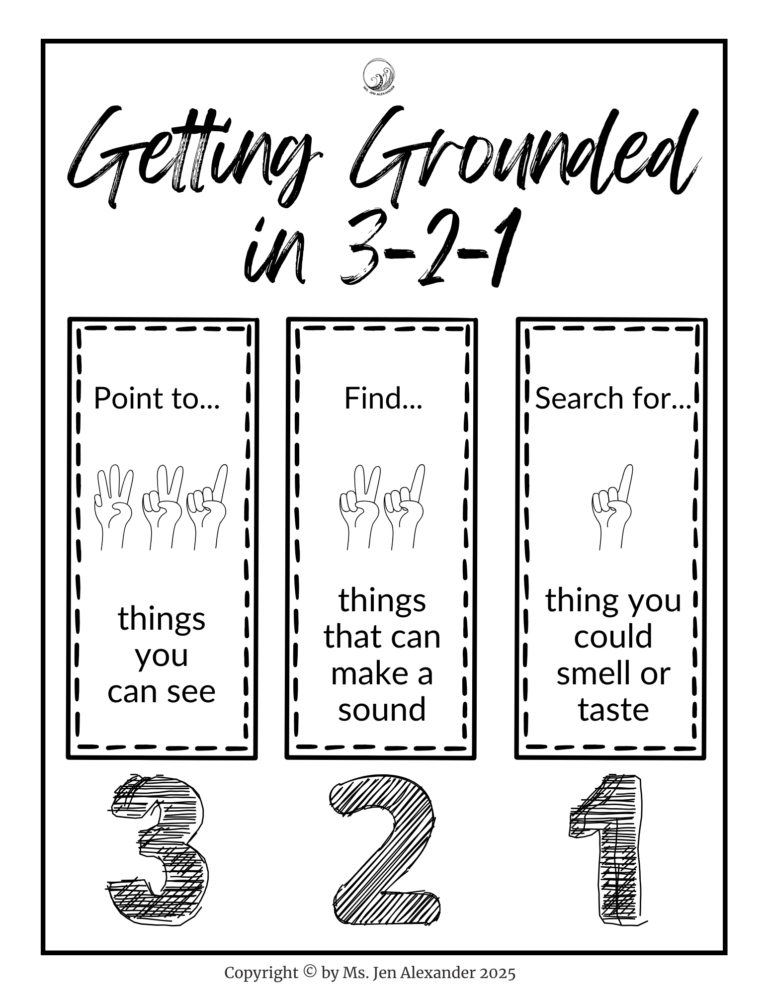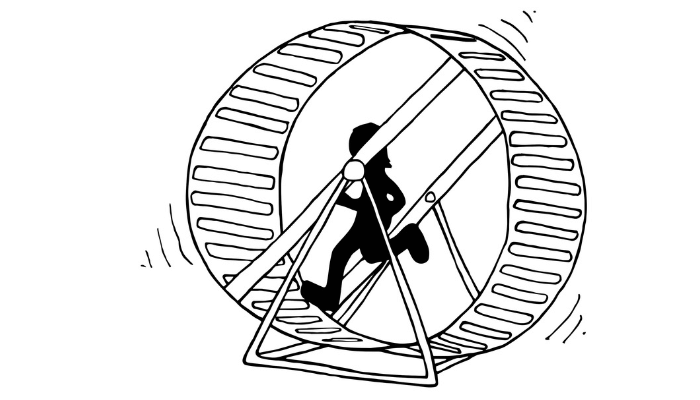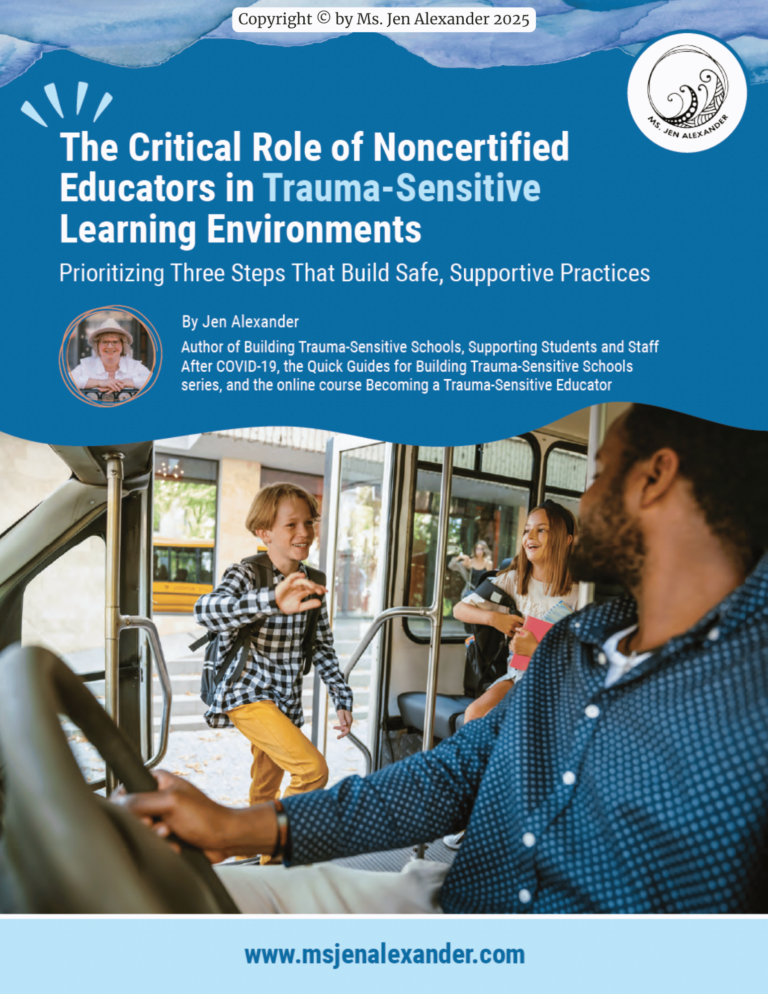“There’s so much anxiety at school—help!” Our crew hears this consistently. We’re guessing you’ve also noticed it. If so, check out the Q&A with Ms. Jen below to get answers to some of your pressing questions about what you can do to help learners who may be experiencing anxiousness—and yourself too!
Question 1: Is Anxiety on the Rise?
Answer: Yes, anxiety is on the rise. and there’s so much anxiety at school. Importantly, it was increasing before the COVID-19 pandemic–likely due to multiple factors. Learn more about it from author, speaker, and founder of BraveBains, Jessica Sinarski, in conversation with Ms. Jen in our April 2025’s YouTube Live. Plus, there are resources for your below!
Yes, anxiety's on the rise!
Ms. Jen Tweet
Question 2: What is Anxiety?
Answer: Anxiety is an experience that we can get stuck in that involves feeling (both emotions and physiological sensations) but also doing or thinking, particularly in relation to worried thoughts. According to the American Psychological Association, anxiety can involve tension and changes like increased blood pressure. Overall, anxiety contributes to worrying and avoidance plus dread. I often imagine anxiety as being on a hamster wheel going ’round and ’round but getting nowhere. The faster I try to figure it out, the worse it may become. What comes up for you when you think about anxiety?
Anxiety is an experience that we can get stuck in that involves feeling (both emotions and physiological sensations) but also doing or thinking, particularly in relation to worried thoughts.
Ms. Jen Tweet
Question 3: Does Experiencing Anxiety Mean Someone Has an Anxiety Disorder?
Answer: No, not necessarily. Anyone can experience anxiousness from time to time, and it doesn’t mean you have an anxiety disorder. You may simply be experiencing a problem that you haven’t yet been able to solve, and sometimes that’s because it’s more than you can figure out alone. Other times, anxiety’s source is a mystery. Sometimes, anxiety is due to the body sounding a stress alarm when it’s not necessary. All that said, anxiety disorders (e.g. phobias, social anxiety disorder, panic disorder, generalized anxiety disorder, and separation anxiety disorder) are some of the most common mental health conditions for adults and youth, affecting health, attendance, relationships, well-being, and learning for both school faculty and students. It’s why we’re focusing on this topic this month.
Anyone can experience anxiousness from time to time, and it doesn't necessarily mean you have an anxiety disorder.
Ms. Jen Tweet
Question 4: Is Post Traumatic Stress Disorder (PTSD) an Anxiety Disorder?
Answer: No, not anymore. Post traumatic stress disorder (PTSD) used to be categorized as an anxiety disorder, but now, in the DSM-V, it’s classified as a trauma- and stress-related condition because it’s directly linked to exposure to a traumatic event or series of events. In short, individuals with PTSD often experience intense patterns of stress responses that can include bigger internal energy like panic, despair, and other emotions plus flashbacks and nightmares as well as a shut down of energy such as anhedonia, dissociation, (and more)—all of this occurs after overwhelming stress, is not caused by something else, and interferes with life functioning. Importantly, it’s not an educator’s job to figure out whether a learner has an anxiety disorder or not, and there are things every educator can do to support humans who experience anxiousness—regardless of its cause.
Post traumatic stress disorder (PTSD) used to be categorized as an anxiety disorder, but now, in the DSM-V, it's classified as a trauma- and stress-related condition because it's directly linked to exposure to a traumatic event or series of events.
Ms. Jen Tweet
Question 5: How Can Educators Help Learners and Themselves With Anxiousness?
Answer: Do your part to stop harm at school, and put relationships first so you can be present for youth and support them in feeling, dealing, and healing through life’s stressors. Let them know that they’re not alone in facing challenges in their own lives or the ones that are impacting us all—collectively. Most importantly, show up, listen, and be there, on their side—no matter what. This doesn’t mean you must agree with every decision every learner makes. Rather, it’s about embodying that you care, want what’s best for them, and won’t give up on nurturing and challenging their growth. To learn more, check out my new free guide The Critical Role of Noncertified Educators in Trauma-Sensitive Learning Environments. It gives every school staff member ideas for putting relationships first. Everyone can feel a little less anxious when we’re not alone!
Everyone can feel a little less anxious when we're not alone!
Ms. Jen Tweet
More General Suggestions for Humans Who Feel Anxious
Here are several more suggestions that can help you help kids (or yourself) when feeling anxious at school.
- Once your classroom community is well established, consider bringing up the topic of anxiety (for big kids, which includes teens) or worries (for younger learners). Invite each person to contribute a word or image that goes with it. Discuss how folks’ contributions are both similar to and different from one another. Discuss what helps or makes it worse.
- Share the definition of anxiety used here (for big kids). Or, for learners in grades PreK-1, read and discuss a book like, Ruby Finds a Worry by Percival (2018). For grades 1-4, try You’ve Got Dragons by Cave (2003) instead.
- Discuss with your group not only what it’s like to experience anxiety but also, what helps (e.g., connecting with someone you trust, distracting oneself when needed, or using coping strategies to release or settle one’s stress responses like movement). The goal isn’t to prevent all anxiety. Rather, it’s to regulate through it.
- Explain that anxiety can be a teacher, but that doesn’t mean it has to be the boss. Discovering patterns and tending to our needs that go with them can be helpful. Anxiety doesn’t get to be in control. In fact, sometimes, getting support so you can decide on a best plan of action for now is important. It may or may not solve everything in the bigger picture, but knowing you’ve thoughtfully decided on your next step can at least pause that hamster wheel!
- Similarly, as you help learners identify patterns, you will likely discover skills they may need more support with (e.g., consider what challenges may be driving avoidance since we all avoid things that we don’t know how to navigate successfully). For instance, is difficulty with peer conflicts potentially contributing to anxiety that results in attendance concerns? If so, work on those skills—together. Let kids know that you’re literally an expert in helping them gain the skills that will help solve problems instead of being stuck in anxiousness about them (or avoiding ’em altogether). Then scaffold their learning so they can be successful—and celebrate success along the way!
- Try Ms. Jen’s 3-2-1 technique for anxiety (or other big reactions) to help one learner or an entire group get grounded in the present moment instead of going faster and faster in an anxious spiral. Use the Getting Grounded in 3-2-1 download to invite folks to quietly point to three things they can see (I like to invite pointing with three fingers, then two, and one). Next, find two things that make sound. Finally, one thing you could smell or taste. Afterwards, note what may have led to that anxiousness and use that information to inform how you teach and coach in the future (once folks are better regulated and ready to learn).

We all avoid things that we don't know how to navigate successfully.
Ms. Jen Tweet
Everybody experiences anxiousness sometimes. Don’t forget there’s support available when you need it! Ensure your students know how and when to seek more support, whether that’s in or outside of school.
Your Next Steps...
1. Download and read my new free guide to learn about putting relationships first, especially as a noncertified educator.
2. Learn more about under and over-functioning in relation to anxiety by listening to Brene´Brown’s podcast (April 3, 2020) on Anxiety, Calm, and Over-/Under-Functioning.
3. Subscribe and watch my new YouTube Lives—happening most months on day 10 @ 5:30 pm Central Time. You can also catch each one on replay!
I see you,

References
American Psychiatric Association. (2013). Diagnostic and statistical manual of mental disorders (5th ed.). https://doi.org/10.1176/appi.books.9780890425596
Cave, K. (2003). You’ve got dragons. Atlanta, GA: Peachtree Publishing Co.
Percival, T. (2018). Ruby finds a worry. New York, NY: Bloomsburry Children’s Books.




